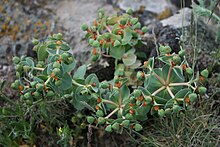Terrarium plant
Under Terrarienpflanzen refers living or artificial plants in a terrarium are. The word terrarium plant is a compound from "terrarium" (from the Latin terra "land, earth") and " plant ". A distinction is made between pure plant terrariums and terrariums with additional keeping of different animals. In the reproduced habitat of the terrarium, the planting and animal husbandry are dependent on their natural environment, depending on the type and requirements.
Artificial terrarium plants
Artificial plantings in a terrarium are replicas of plants as they occur in nature and, together with various decorative materials, simulate a living space . The artificial plants mostly consist of plastic, polyester and silk . They hardly need any maintenance and are easy to clean. The arrangement of the plants depends on the type of terrarium and the corresponding animal husbandry. It can be tailored to the needs of the animals. B. many artificial plants with a reptile-friendly surface. Artificial plants are not damaged quickly. Swallowed leaves can be dangerous for kept animal species.
Live terrarium plants
The natural habitat of terrarium plants is imitated by different types of terrarium. Living plants are not needed in a terrarium for the oxygen supply. With additional animal husbandry, however, living plants create opportunities to hide, climb or lay eggs. Poisonous plants, or those with dangerous thorns, are unsuitable when keeping animals at the same time.
Classification of living plants according to terrarium type
- Dry terrarium: This is where succulent plants develop, including, for example: agave plants , euphorbia , cryptanthus and cacti .
- Savannah terrarium: The savannah terrarium is a sub-form of the dry terrarium in which small wart or prickly pear cactus species unfold.
- Rainforest terrarium : Other names for a rainforest terrarium are the wet terrarium or the tropical or primeval forest terrarium. Here grow u. a. the following types of plants: flamingo flowers , bamboo , efeutute and the climbing fig (lat. Ficus pumila). Green, smooth-leaved species from the bromeliad family and many tropical ferns also thrive in a rainforest terrarium . Orchids , for example from the genera Brassavola , Dendrobium , Leptotes or Phalaenopsis , find optimal climatic conditions in a rainforest terrarium. Mosses grow from tree fern plates if they are sufficiently moistened.
- Forest terrarium: With its humidity and temperature values, the forest terrarium lies between a dry and rainforest terrarium. In this climate z. B. ivy , ferns, ivy, moss and the climbing fig.
- Aquaterrarium: In the humid climate of an aquaterrarium z. B. following plants: horn leaf , spear leaves and Java fern . Java moss grows on man-made waterfalls and man-made, damp banks.
- The paludarium is a sub-form of the aquaterrarium and recreates a swampy landscape. A distinction is made between plant species that grow as aquatic plants completely under the water (lat. Submers = submerged), such as. B. Vallisneria , or the streaky pondweed and the plants that live above the surface of the water (lat. Emers = emerged) protrude, such as. B. spear blades , Spathiphyllum species and sedge grass . Swamp plants from the genera of water hyacinths , floating ferns and pistia , especially those with strong stems, grow above the surface of the water as floating plants. Creeping water-hose species develop on the ground between the moss of paludariums .
literature
- Eugène Bruins: Terrarium Encyclopedia. Dörfler Verlag, Eggolsheim 2006, ISBN 3-89555-423-5 .
- Oliver Drewes: Terrarium animals from A to Z. Graefe and Unzer Verlag, Munich 2004, ISBN 3-7742-6316-7 .
- Friedrich Wilhelm Henkel, Wolfgang Schmidt: Invertebrates for the terrarium. Eugen Ulmer, Stuttgart 2010, ISBN 978-3-8001-5156-1 .
Web links
Individual evidence
- ↑ Eugène Bruins: Terrarium Enzyklopädie, Dörfler Verlag, Eggolsheim 2006, ISBN 3-89555-423-5 , p. 34.

